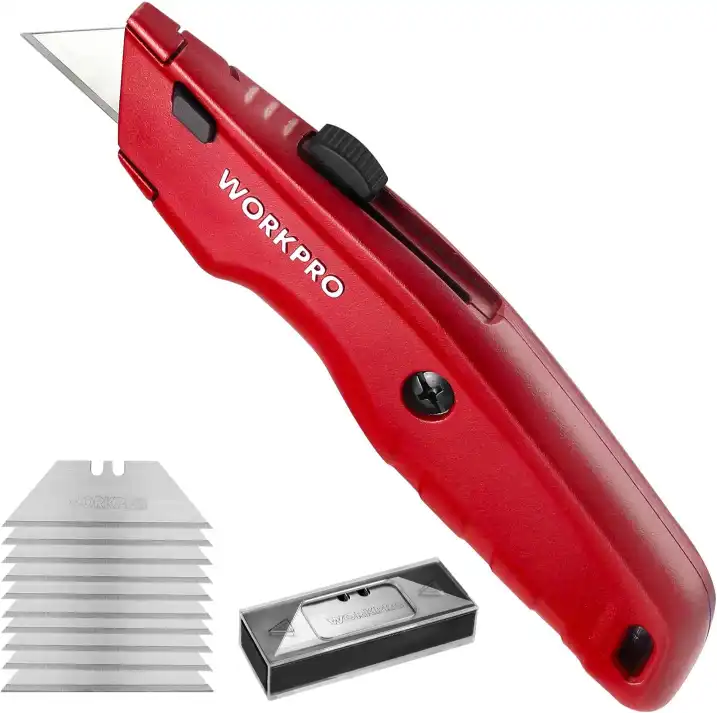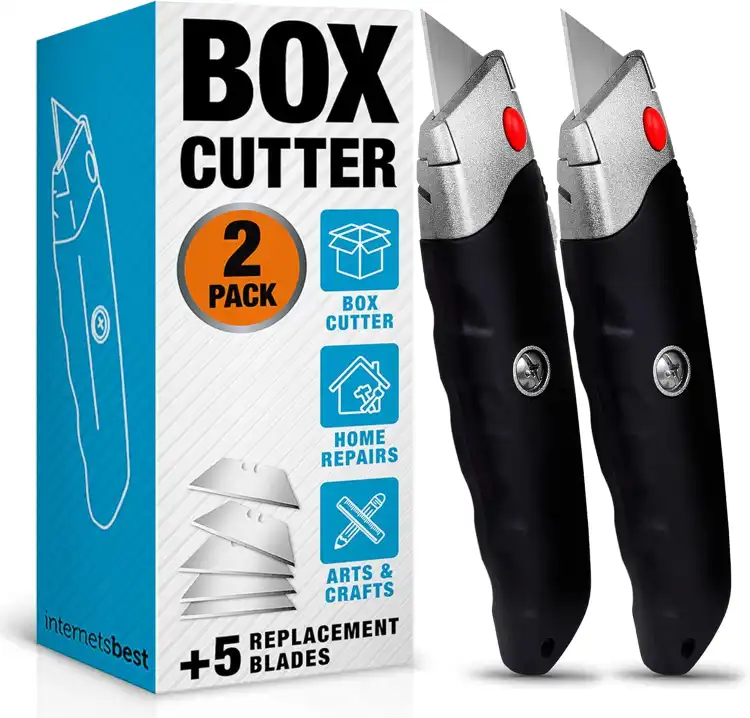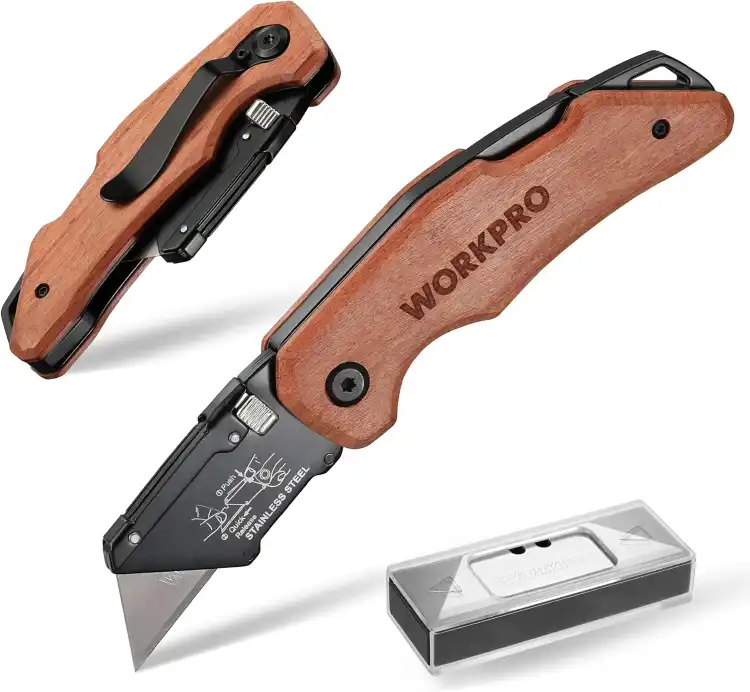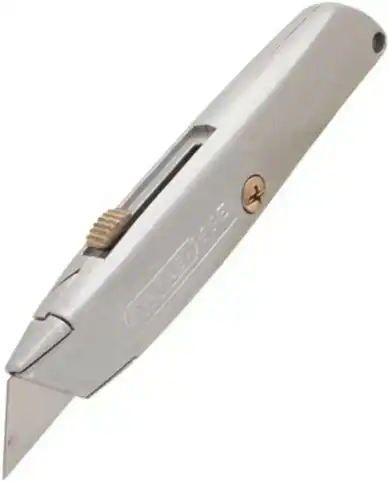Better Safe Than Sorry: A Guide to Using Utility Knives
Utility knives are versatile tools commonly used in various industries for cutting materials such as cardboard, plastic, and even carpet. While these knives are incredibly handy, they can also be dangerous if not used properly. Safety should always be a top priority when handling utility knives to prevent accidents and injuries.
Our Top Utility Knife Picks

WORKPRO Premium Utility Knife
Check on AmazonKey Specs:
- Material: Aluminum alloy and metal
- Blade: SK5 razor blade with 64 HRC
- Size: 6.3″ x 1.7″ x 0.9″
- Blade Features: Retractable with 3 adjustable positions
- Extras: Includes 10 extra double-use blades
The WORKPRO Premium Utility Knife is a top choice for heavy-duty cutting. Its aluminum alloy frame, paired with a rust-resistant powder coating, offers both durability and lightweight handling. I appreciate the ergonomic design that makes it comfortable to hold during prolonged use. The retractable blade feature is a game changer for safety, while the quick-change system makes blade replacements effortless. With 10 extra double-use blades, this utility knife is perfect for precision and general cutting tasks around the house or on the job.

INTERNET’S BEST Premium Utility Knife Set
Check on AmazonKey Specs:
- Material: Metal body, rubber handle
- Blade Length: 2 inches
- Included Items: 2 utility knives, 5 extra blades
- Handle Type: Rubber for enhanced grip
- Dimensions: 6 inches length, 1.5 inches width
The INTERNET’S BEST Premium Utility Knife Set offers unbeatable versatility for heavy-duty cutting tasks. I love the ergonomic rubber handle that provides a secure and comfortable grip, even during prolonged use. The retractable blade ensures safety, while the quick-change mechanism allows for fast and easy blade swaps, minimizing downtime. With extra blades included, this set guarantees you’re always prepared. Whether I’m cutting cardboard, carpet, or plastic, these knives provide consistent, clean cuts every time.

DeWalt DWHT10046 Rugged Metal Body Retractable Utility Knife w/Lockable Blade
Check on AmazonKey Specs:
- Material: Metal body, stainless steel blade
- Blade Length: 2.5 inches
- Weight: 0.5 pounds
- Handle: Dual-material for improved grip
- Blade Change: Rapid load system for quick blade swaps
The DeWalt DWHT10046 Rugged Metal Body Retractable Utility Knife is built to last. I appreciate the rugged metal body that withstands tough conditions, ensuring long tool life. The rapid load blade changing system is incredibly convenient, allowing for quick blade swaps, while the built-in blade storage ensures I always have a replacement nearby. The retractable blade offers adjustable depth, providing precise cuts, and the dual material handle enhances grip and control. It’s a reliable tool for all types of cutting tasks.

WORKPRO Folding Utility Knife
Check on AmazonKey Specs:
- Material: Wood handle, stainless steel head
- Blade Length: 2.38 inches
- Weight: 0.25 kilograms
- Handle Type: Ergonomic rosewood
- Includes: 10 extra SK5 blades
The WORKPRO Folding Utility Knife is a standout with its high-quality rosewood handle, offering a vintage yet durable design. The quick-change blade mechanism is a fantastic feature, allowing for effortless blade swaps, and it’s compatible with most standard utility blades. The back lock ensures safety, keeping the blade securely in place while working. With the ergonomic grip and belt clip, this knife is portable and comfortable to use for various tasks like cutting paper, plastic, leather, and more.

Stanley Utility Knife
Check on AmazonKey Specs:
- Material: Alloy steel blade and handle
- Blade Storage: Convenient storage in handle
- Blade Positions: 3-position retractable blade
- Includes: 3 extra blades
- Weight: 0.01 pounds (lightweight)
The Stanley Utility Knife set is a reliable choice for everyday cutting tasks. The 3-position retractable blade allows for versatility in cutting depth, while the patented interlocking nose keeps the blade secure, even during intense use. I especially appreciate the blade storage in the handle, which ensures you always have replacements on hand. The alloy steel blade starts sharp and stays sharp, making this knife a durable and efficient tool for a wide range of materials.
Brief Overview of Utility Knives
Utility knives, also known as box cutters or razor knives, are designed for general or utility use. They typically feature a retractable blade that can be adjusted to different lengths for various cutting tasks. These knives are popular for their precision and ease of use in cutting a wide range of materials.
Importance of Safety When Using Utility Knives
Safety is paramount when it comes to using utility knives. Accidents involving these tools can lead to serious injuries if proper precautions are not taken. By following safety guidelines and using the right protective gear, users can minimize the risks associated with handling utility knives.
Understanding the Utility Knife
Types of Utility Knives
There are several types of utility knives available, including retractable blade knives, snap-off blade knives, and fixed blade knives. Each type has its own advantages and is suited for different cutting tasks. It’s essential to choose the right type of utility knife for the job at hand.
| Type | Description |
|---|---|
| Retractable Blade Knives | Feature a blade that can be adjusted to different lengths and retracted for safety. |
| Snap-Off Blade Knives | Have segmented blades that can be snapped off to reveal a new sharp edge. |
| Fixed Blade Knives | Have a non-retractable blade that is permanently attached to the handle. |
Parts of a Utility Knife
A typical utility knife consists of several key parts, including the handle, blade, blade release button, and blade storage compartment. Understanding the different components of a utility knife is essential for safe and effective use of the tool.
- Handle: The part of the knife that is held during use.
- Blade: The cutting edge of the knife that can be retracted or replaced.
- Blade Release Button: Used to extend or retract the blade.
- Blade Storage Compartment: Where additional blades can be stored for easy access.
Importance of Safety
Statistics on Utility Knife Accidents
According to recent studies, utility knife accidents account for a significant number of workplace injuries each year. Many of these accidents are preventable with proper safety measures and training. It’s crucial to be aware of the risks associated with using utility knives.
Common Injuries Associated with Utility Knives
Common injuries resulting from improper use of utility knives include cuts, lacerations, and puncture wounds. These injuries can range from minor cuts to severe wounds that may require medical attention. By following safety protocols, users can reduce the likelihood of such injuries.
Safety Gear
Proper Attire for Using a Utility Knife
When using a utility knife, it’s essential to wear appropriate attire to protect yourself from potential injuries. Avoid loose clothing that could get caught in the blade and opt for fitted garments that allow for ease of movement. Additionally, closed-toe shoes are recommended to protect your feet.
Importance of Wearing Gloves and Eye Protection
Gloves and eye protection are crucial safety gear when using a utility knife. Cut-resistant gloves can provide an extra layer of protection against accidental cuts, while safety glasses or goggles shield your eyes from debris and potential blade fragments. Always prioritize safety gear when working with utility knives.
Proper Handling Techniques
How to Hold a Utility Knife Correctly
Proper grip and hand placement are essential for safe handling of a utility knife. Hold the knife firmly with your dominant hand, keeping your fingers away from the blade. Use your other hand to stabilize the material being cut, ensuring a steady and controlled motion.
Techniques for Cutting Safely
When cutting with a utility knife, apply steady pressure and use a smooth, controlled motion. Avoid rushing or making abrupt movements that could lead to slips or accidents. Always cut away from your body and maintain focus on the task at hand to prevent injuries.
Blade Safety
Inspecting the Blade Before Use
Prior to using a utility knife, inspect the blade for any signs of damage or wear. A dull or damaged blade can increase the risk of accidents and result in uneven cuts. Replace the blade if necessary to ensure smooth and safe cutting operations.
How to Change Blades Safely
When changing blades on a utility knife, follow the manufacturer’s instructions carefully. Use caution when handling sharp blades and always dispose of used blades properly. Keep spare blades in a secure container to prevent accidental injuries when accessing them.
Storage and Maintenance
Proper Storage of Utility Knives
Store utility knives in a designated area away from reach of children or unauthorized personnel. Keep blades retracted when not in use and store the knife in a secure position to prevent accidental exposure. Proper storage ensures the safety of both users and others in the vicinity.
Regular Maintenance to Ensure Safety
Regular maintenance of utility knives is essential to ensure their safe and efficient operation. Clean the knife after each use to remove debris and inspect the components for any signs of wear. Lubricate moving parts as needed to maintain smooth functionality and extend the tool’s lifespan.
Workspace Safety
Keeping the Workspace Clean and Organized
A clutter-free workspace is essential for safe knife handling. Keep your work area clean and organized to prevent accidents caused by tripping over objects or knocking items onto the floor. Clear away debris and materials that could obstruct your movements while using a utility knife.
Creating a Designated Cutting Area
Designate a specific area in your workspace for cutting tasks to minimize the risk of accidents. Use a stable work surface with ample lighting to ensure visibility while cutting. By creating a dedicated cutting area, you can focus on the task at hand and reduce distractions that may lead to injuries.
Avoiding Distractions
Importance of Focusing When Using a Utility Knife
Distractions can significantly increase the likelihood of accidents when using a utility knife. Stay focused on the cutting task and avoid multitasking or engaging in conversations while handling the knife. Concentrate on your movements and maintain awareness of your surroundings to prevent injuries.
Tips for Minimizing Distractions in the Workshop
To minimize distractions in the workshop, establish clear work procedures and communicate safety guidelines to all personnel. Limit noise and interruptions in the cutting area to maintain a focused environment. Encourage a safety-conscious culture where everyone prioritizes safe practices when using utility knives.
Safe Cutting Practices
Cutting Away from the Body
Always cut away from your body when using a utility knife to reduce the risk of self-inflicted injuries. Position the material to be cut in a way that allows you to apply downward pressure away from your body. This technique helps prevent accidental slips that could result in cuts or lacerations.
Using a Cutting Mat or Surface
Protect your work surface and prolong the life of your blades by using a cutting mat or surface. A self-healing cutting mat provides a stable and safe area for cutting materials without damaging the underlying table or countertop. Invest in a quality cutting mat to enhance safety and precision in your cutting tasks.
Handling Emergencies
First Aid Tips for Cuts and Injuries
In the event of a cut or injury while using a utility knife, it’s essential to administer first aid promptly. Clean the wound with soap and water, apply pressure to stop bleeding, and cover the cut with a sterile bandage. Seek medical attention if the injury is deep or shows signs of infection.
Knowing When to Seek Medical Help
Serious cuts or injuries caused by a utility knife may require medical intervention beyond basic first aid. If the wound is deep, continues to bleed heavily, or shows signs of infection such as redness or swelling, seek medical help immediately. Do not attempt to treat severe injuries on your own.
Training and Education
Importance of Proper Training in Using Utility Knives
Proper training in the use of utility knives is crucial for preventing accidents and injuries in the workplace. Employers should provide comprehensive training programs that cover safety protocols, handling techniques, and emergency procedures. Regular training sessions ensure that employees are equipped to use utility knives safely.
Resources for Learning About Utility Knife Safety
There are various resources available for individuals seeking to learn more about utility knife safety. Online tutorials, safety manuals, and workshops offer valuable information on best practices for using utility knives. Take advantage of these resources to enhance your knowledge and skills in safe knife handling.
Legal and Ethical Considerations
Following Workplace Safety Regulations
Adhering to workplace safety regulations is not only a legal requirement but also an ethical responsibility. Employers must ensure that employees are provided with a safe working environment and proper training in using tools such as utility knives. By following safety regulations, organizations demonstrate their commitment to prioritizing employee well-being.
Ethical Responsibility to Prioritize Safety
Individuals using utility knives have an ethical responsibility to prioritize safety in their work practices. By following safety guidelines, wearing protective gear, and maintaining awareness of potential hazards, users can prevent accidents and protect themselves and others from harm. Safety should always be the top priority when handling utility knives.
Common Mistakes to Avoid
Rushing While Using a Utility Knife
One common mistake when using a utility knife is rushing through cutting tasks. Hasty movements can lead to slips, inaccurate cuts, and potential injuries. Take your time, focus on the task at hand, and maintain a steady pace to ensure safe and precise cutting operations.
Using a Dull or Damaged Blade
Using a dull or damaged blade poses a significant safety risk when using a utility knife. A blade that is not sharp enough can slip during cutting, causing accidents and uneven cuts. Regularly inspect the blade for sharpness and replace it when necessary to maintain safe cutting practices.
Conclusion
In conclusion, safety is paramount when it comes to using utility knives. By understanding the different types of utility knives, following proper handling techniques, and prioritizing safety gear, users can minimize the risks of accidents and injuries. Remember to always inspect blades, maintain a clean workspace, and seek proper training to ensure safe and efficient use of utility knives in various applications.
FAQ
How often should I change the blade of a utility knife?
A: It is recommended to change the blade of a utility knife whenever it becomes dull or damaged. Regularly inspect the blade for signs of wear and replace it as needed to ensure safe cutting operations.
Can utility knives be used for cutting hard materials like metal?
A: While utility knives are primarily designed for cutting materials like cardboard and plastic, some models with heavy-duty blades can cut through thin metal sheets. However, it is essential to use the appropriate blade and technique for cutting metal safely.
How should I dispose of used utility knife blades?
A: Used utility knife blades should be disposed of in a puncture-resistant container or a designated sharps disposal box. Do not throw used blades directly into the trash to prevent injuries to waste handlers.
